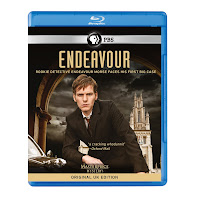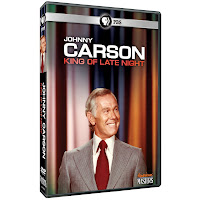Brake
(IFC)
An admittedly ingenious story
device—Secret Service agent trapped in a car trunk must figure out a D.C.
terrorist plot before bombs burst in air—is ruined by a twist stolen from the
very first Twilight Zone episode.
Then, as if admitting to the theft, writer Timothy Mannion unveils another dastardly
twist, which falls flat. Since nearly the entire 90-minute movie takes place in
an enclosed box, Stephen Dorff must be commended for his controlled hysterics and
apparent lack of claustrophobia. Director Gabe Torres cleverly keeps viewers
from suffocating; on Blu-ray, the movie’s visuals look sharp. Extras are a
Torres commentary, music video and making-of featurette.
(PBS)
Famed British detective Inspector
Morse had to begin somewhere, and Endeavour
shows where, as the green but aggressive rookie tackles the case of a teenage
schoolgirl gone missing near Oxford. With assorted characters that have
something to hide—including a former opera singer, whom the young Morse adores,
whose husband may have been mixed up with the unfortunate girl—Endeavour is a worthy addition to the Masterpiece Mystery family. Solid acting
by Sean Lewis, Roger Allam and Flora Hemingway complements a satisfying script;
the hi-def transfer is excellent.
(Fox)
If Mel Gibson is really looking
to rehabilitate his image, he should pick better scripts than this one by Apocalypto co-writer Adrian Grunberg, also
making his directing debut. Favoritism is one thing, but this idiotic adventure
about an American jailed in Mexico who must save himself and others before bad
guys get them balances flavorful dialogue with ridiculously thin characters. Gibson
gets by on his natural charisma, but the others are close to offensive
caricature (although with that title, it’s not surprising). The movie has a
good Blu-ray transfer; extras include a making-of featurette and music video.
(Kino)
Derek Jarman’s angry screed
against his country being destroyed from within by Thatcher’s conservative
government has lost none of its visceral power since its 1987 release and
contains indelible visuals, especially those featuring then-muse Tilda Swinton,
only a blip on Hollywood’s radar back then. Still, Jarman’s ranting rarely
coheres into something tangible, as it does far more strongly in his next film,
the AIDS paean, The Garden. In this fine
hi-def transfer, England etches a specific
time and place.
(Anchor Bay)
Writer-director D.W. Brown’s
unconvincing prison drama fails in its attempt to create a sympathetic
character in a killer sentenced to a psych ward with men crazier and more
psychopathic than he. And while Nick Stahl makes a fairly credible protagonist,
both Dash Mihok and Pruitt Taylor Vince are too obvious as his prison foils,
and the always appealing Olivia Wilde is totally wasted in a silly “romantic”
role. The movie does have a top-notch hi-def transfer, however.
Peter Gabriel: Secret World Live
(Eagle Vision)
This film of Peter Gabriel’s 1994
tour supporting his Us CD finally
gets the spectacular hi-def treatment. The upgraded DTS-HD sound is
impressively enveloping: every nuance of Gabriel’s vocals and his ace backing
band’s playing clearly heard. The 16mm film has also gotten a thorough visual
restoration. Of course, the concert’s a knockout musically, and Peter’s duets
with backing vocalist (and soon to be hitmaker) Paula Cole on “Come Talk to
Me,” “Blood of Eden” and “Don’t Give Up” are among his most impassioned. Extras
include “Red Rain” (why isn’t it part of the film?), a Gabriel interview, behind-the-scenes
footage and “Rhythm of the Heat” from his 2010 orchestral tour.
(PBS)
Trevor McDonald’s four programs about
how the British see their queen in her Diamond Jubilee Year and, by extension,
the institution of the monarchy itself, is a fascinating cultural history
lesson. The quartet—London: Royal City,
Royal Visit, The Queen’s Possessions and Traveler—is narrated by McDonald, who interviews people ranging
from one of the queen’s photographers to a “Beefeater” (queen’s guard). The
show was shot in splendid hi-definition, which includes glimpses of the
picturesque Channel Islands, where inhabitants think of themselves as part of
but separate from their country.
(Kino)
Alberto Cavalcanti—then known simply
as Cavalcanti (take that, Sting and Madonna)—directed this bleak film noir in
1947, and it remains amazingly modern. Amid the usual noirish trappings, Trevor
Howard superbly plays a war veteran hardened by work in the criminal underworld.
Otto Heller’s marvelous black and white photography has so many shades of gray,
reminding us that nothing’s either black or white in this sordid world; the
movie looks terrific on Blu-ray.
Black Butterflies
(Tribeca Film)
Deserved winner of the 2011
Tribeca Film Festival’s Best Actress award, the Netherlands’ Carice van Houten fearlessly
portrays South African poet Ingrid Jonker, an unforgettable performance that overshadows
the rest of Paula van der Oest’s biopic. Some good, intense sequences visualize
Jonker’s tortured psychology, but too often Butterflies
falls into the melodramatic trap of similar screen biographies. But Houten is so
shattering that it rarely matters. Extras include van der Oest and van Houten interviews.
(e one)
In Nacho Vigalondo’s smart sci-fi
thriller-cum-romantic comedy, a lovely young woman, her boyfriend, a one-night-stand
and a nosy neighbor wonder whether any of the others is one of “them”: aliens
that have landed on earth. The tongue-in-cheek humor makes up for lazy
exposition as each person’s suspicions don’t pan out. The performances (notably
by knockout Michelle Jenner) keep Vigalondo’s intriguing but one-note concept amusing
for 90 minutes. Extras include three Vigalondo shorts and a making-of
featurette.
(PBS)
Henry Louis Gates Jr’s genealogy
series continues with episodes that enlighten celebrities of their lineage—with
surprises such as when married couple Kevin Bacon and Kyra Sedgwick learn that
they are ninth cousins. Others interviewed are musicians Harry Connick and
Branford Marsalis, actors Samuel L. Jackson, Robert Downey and Maggie
Gyllenhaal, and politicians Condoleezza Rice and Cory Booker. Gates’ chronicles
are historically relevant and engaging to watch as famous people become
emotional while discovering their ancestors.
(ABC)
These new ABC drama series
revolve around immensely likeable leading ladies: Missing stars Ashley Judd as a former CIA agent who takes it upon
herself to find her kidnaped son in Europe, while Revenge stars Kerry Washington as head of a crisis management
agency that uses its expertise to hush up possible scandals in Washington D.C. While
both shows unabashedly traffic in implausibilities, good writing, acting and a
quick pace compensate. Extras are interviews and behind the scenes snapshots; Missing also includes deleted scenes.
(First Run)
This remarkable documentary
presents the history of the Jacob’s Pillow Dance Festival, one of the
Berkshire’s summer jewels. For 80 years, renowned choreographers and performers
descend upon Jacob’s Pillow to perform cutting-edge, controversial, thought-provoking
modern and classical dance works. Narrated by choreographer Bill T. Jones, Ron
Honsa’s film includes interviews with Suzanne Farrell and Mark Morris, and
succinctly summarizes the place’s historical and artistic importance. Extras
include a brief Merce Cunningham interview and additional performance snippets.
(First Run)
Brian Lilla’s urgent expose of a
massive dam project threatening Chile’s Patagonia region is cinematic advocacy
at its most revelatory. The project, comprising five dams along two rivers,
purports to help millions receive needed electricity, but experts insist it
will destroy one of the world’s most fragile eco-systems, and that alternative
forms of energy are preferable. Lilla methodically covers both sides, even
though it’s obvious where he sits. The project’s PR mouthpiece comes off slick
and rehearsed, but more troubling are sincere but naive comments from people
who live in Santiago, who feel the dams are needed for their well-being
(needless to say, most are young adults).

















































